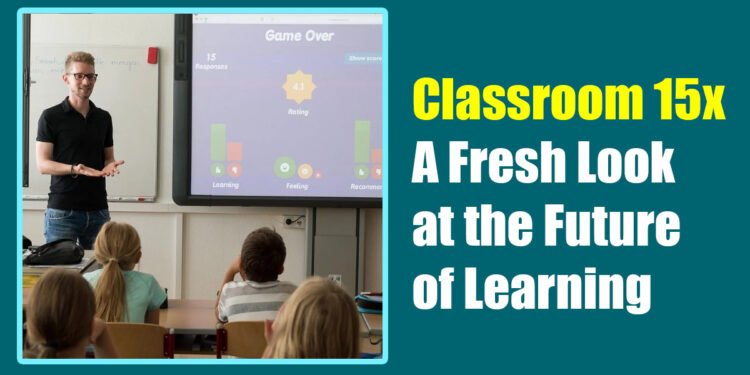Education is changing rapidly, and traditional classrooms are no longer the only path to learning. The concept of Classroom 15x has emerged as a new way to design and experience education. It promises a blend of technology, flexibility, and human-centered design. This article explores what Classroom 15x is, why it matters, the benefits it brings, and the challenges schools must consider.
What is Classroom 15x?
Classroom 15x is not a single product but a vision of modern learning environments. It emphasizes adaptive spaces, deep technology integration, and student-centered learning. The term “15x” suggests multiplying the effectiveness of traditional classrooms whether in engagement, retention, or flexibility.
Different educators interpret it in different ways. For some, it means smaller class sizes, around 15 students, for more personalized instruction. For others, it represents classrooms that are 15 times more interactive and future-ready than the conventional model. Whatever the interpretation, the central idea is a classroom designed for the needs of today and tomorrow.
Flexible Learning Spaces
One of the cornerstones of Classroom 15x is flexibility. Instead of rigid rows of desks, furniture can move, and spaces can change according to the lesson. A math lesson might start with a group problem-solving session at shared tables, followed by quiet individual practice in a calm corner. Project-based work can happen in zones designed for collaboration, while independent reflection can take place in quiet pods.
Flexibility makes the classroom adaptable. The room becomes a tool in the learning process, instead of a limitation.
Technology at the Core
Technology is deeply embedded in Classroom 15x. Interactive smartboards replace chalkboards. Every student may have access to a tablet or laptop. Virtual reality and augmented reality modules can bring abstract concepts to life. Learning management systems connect teachers, students, and parents in real time.
Technology is not just an add-on; it is integrated into the daily learning routine. Data dashboards provide insights into student progress, allowing teachers to intervene when needed. Digital tools expand the classroom beyond its four walls.
Personalized Learning
A defining feature of Classroom 15x is personalization. Instead of a one-size-fits-all approach, adaptive systems adjust content to each learner’s pace and style. A student who struggles with algebra can receive targeted support while another student moves ahead to more complex topics.
Teachers act as facilitators, guiding students and ensuring they are supported. Students also take more responsibility, setting goals and tracking their growth. This empowerment leads to greater ownership of learning.
Collaboration and Social Learning
Learning is not only individual. Classroom 15x creates spaces for students to collaborate. Group projects, peer discussions, and shared digital platforms are common. Interactive boards and shared devices allow ideas to flow easily.
This approach builds communication skills, empathy, and teamwork. These are essential skills in the modern world and align well with real-life challenges where collaboration is often key.
Focus on Well-being
Classroom 15x is also about creating a space where students feel comfortable and supported. Design choices include natural lighting, ergonomic seating, and quiet zones for reflection. Plants and sustainable materials contribute to a healthy and calming atmosphere.
Such environments can reduce stress and increase focus. When students feel comfortable, they are more likely to engage and learn effectively.
Benefits of Classroom 15x
The benefits of Classroom 15x are wide-ranging. Engagement increases when students are active participants rather than passive listeners. Studies and pilot projects suggest higher retention rates when interactive tools are used.
Personalization ensures that no student is left behind. Teachers save time through automated systems, freeing them to focus on mentoring and guiding. Students gain future-ready skills like problem-solving, digital literacy, and adaptability.
Hybrid learning models also improve accessibility. Students who cannot attend physically can still participate online, ensuring continuity of education.
Challenges and Considerations
Despite its promise, Classroom 15x faces challenges. Technology and infrastructure upgrades require significant investment. A single Classroom 15x setup can cost tens of thousands of dollars.
Teachers need proper training. Without a shift in mindset, technology risks becoming a distraction. Equity is another concern students without reliable devices or internet access may fall behind. Privacy and data security must also be carefully managed.
Schools must balance enthusiasm with practical planning to ensure sustainability.
A Glimpse into Practice
Imagine a typical day in Classroom 15x. Students enter and log in on their devices. They take a quick adaptive quiz to gauge readiness. Some move to a group station for a science simulation, others explore a history lesson through VR, while a few receive direct coaching from the teacher.
Later, students come together to work on a project, using shared boards and digital resources. In the afternoon, they reflect on their learning, while teachers review data dashboards to plan support.
This vision shows how flexibility, technology, and personalization come together.
The Road Ahead
The future of Classroom 15x is still unfolding. Artificial intelligence could enhance adaptive learning, wearable devices might monitor student well-being, and global classrooms may emerge through virtual spaces.
But even as technology evolves, the human element remains central. Teachers, relationships, and creativity are at the heart of effective learning. Classroom 15x must enhance, not replace, these human connections.
Conclusion
Classroom 15x represents a bold step into the future of education. It combines flexibility, technology, personalization, collaboration, and well-being into a holistic vision. The benefits are promising: higher engagement, stronger retention, and better preparation for the modern world.
Yet challenges remain costs, training, equity, and privacy must be addressed carefully. For schools, the path forward may be gradual: pilot projects, teacher support, and steady scaling.
What is clear is that education is changing. Classroom 15x offers a glimpse of how learning spaces can evolve to meet the demands of a new era. If implemented with care and vision, it could become a model that shapes the classrooms of tomorrow.
FAQs
What does Classroom 15x mean?
Classroom 15x is a modern vision of education that blends flexible design, technology, and personalized learning to create more engaging and effective classrooms.
Why is it called Classroom 15x?
The “15x” represents the idea of multiplying the effectiveness of traditional classrooms, whether through engagement, retention, or adaptability. It can also hint at smaller class sizes or futuristic approaches.
What are the main benefits of Classroom 15x?
Key benefits include higher student engagement, better knowledge retention, personalized instruction, improved collaboration, and stronger preparation for future skills.
What challenges might schools face with Classroom 15x?
Challenges include high setup costs, the need for teacher training, equity issues for students without access to technology, and data privacy concerns.
Is Classroom 15x already in use?
Some schools and institutions are experimenting with Classroom 15x features, often through pilot projects. Full-scale adoption is still in development but growing steadily.










